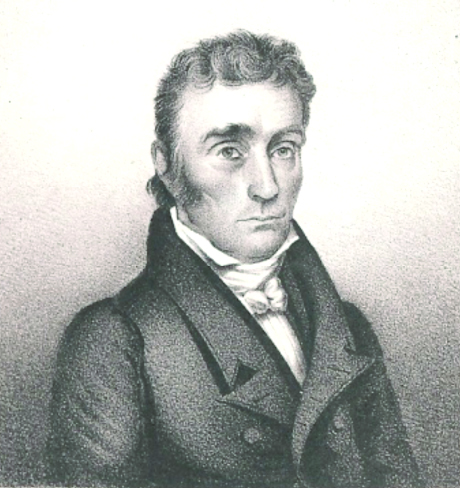Reprinted from the Summer 2008 Hartland Historical Society Newsletter

The Gallup family is one of the most remarkable to be found anywhere. Hartland was most fortunate to have many of its members settle here. One branch settled in the Weed District and we have a Gallup cemetery in that area and, at one time, there was a Gallup School. Another branch settled on what is now Rte. 5, where the Whites Dairy Supply is now located. The cemetery on the west side of Rte 5 is also a Gallup Cemetery, sometimes referred to as the Dunbar or Wyman Cemetery. Dr. Gallup was raised in a house that stood on the White land. Quoting from May Roger’s work done in 1963 we learn the following.
Joseph Gallup, born in Stonington, Conn., March 20, 1759, was about six years old when his father brought his family to Hartland. The means of his early education is not known but it included a command of good English, some Latin and Greek and the ability to read French. In 1787, when he was 18, he began his study of medicine under a “preceptor”, the method of instruction in this profession prevailing at that time. This supplemented by the required number of lectures qualified him to begin practice when he reached his 21st birthday Mar. 30, 1790, the earliest age when such practice could be legal. This practice began in Hartland and the neighboring towns of Bethel and Woodstock. In 1791 he bought property in Bethel and was established there in 1793. In May of 1792, by an appointment dated and signed by his uncle, Col. George Dennison, he became surgeon of the militia. In Sept. of that year, he married Abigail Willard of the Hartland’s Willard families, and their first child was born there in May 1793. For better location and a wider field of activity, he moved to Woodstock in 1800. He received the degree of Bachelor of Medicine in 1798, the first to receive an earned medical degree from Dartmouth as distinguished from the honorary degree which he had received earlier. He received the degree of Doctor of Medicine in 1814. Middlebury College conferred the degree of Master of Arts in 1823.
In these years, medical societies were beginning to be formed and a charter was granted to the Vermont Medical Society of Castleton, Vt. In Oct, 1813 Dr. Gallup was elected it’s president for ten successful terms until he refused in 1829. He was already a teacher and lecturer of high repute and a writer on medical subjects, being deemed the most prominent man in the profession in New England.
Progressively welcoming all advances in medical practice, he was first in the use of the new vaccination for small pox, a great scourge in those days. Upon the discovery in 1796, by Edward Jenner, an Englishman, of the much greater effectiveness of cow pox in the inoculations for this dread disease, it was tried, tested and established by Dec 16, 1804. Already, Dr. Gallup had advertized in the Vermont Journal of Windsor, issue of Jan. 11, 1803, that he was prepared to vaccinate with cow pox. A book written by Dr. Gallup on the subject was current in 1798.
Dr. Gallup’s election to the presidency of the Vermont Medical Society of Castleton occurred on Dec. 10, 1820. He held all the official positions by Jan. 1821, continued teaching there for 3 years but resigned in Jan. 1824. Dr. Gallup had long had dreams of a school of medicine and these were brought to fruition by the founding of the Medical College in Woodstock which he achieved in 1826, and of which he was the sole owner and supporter during its difficult early years, at times at considerable financial loss. The first session of the Clinical School of Medicine (the name adopted) was from March to late May of 1827. Midway in this session Dr. Gallup bought of Abraham Stearns about 3/4 of an acre of land in the western part of the village of Woodstock. He paid $325 for this plot of land and here he erected a building, still at his own expense, for the purpose of holding lectures in 1828. This fine brick building of 7 rooms and basement story was the home of this medical school until1839, when the larger building was erected on College Hill. The original building was remodeled for residential purposes (still a home in 1969).
A difference of opinion arose between Dr. Gallup and two ambitious young medics, Drs Palmer and Parker. These men wanted to do outside teaching for the larger income. Dr. Gallup did not favor peripatetic professors as he felt it lessened allegiance to his College and also interfered with his cherished plan for continuous instruction throughout the calendar year. Bitterness mounted. The arrogant effrontery and caustic criticism of Dr. Gallup by these men who had been professors on his teaching staff and received of his beneficence evoked his decision to resign. This so stirred the people of Woodstock that a meeting was called. A large gathering on the stormy evening of Jan. 6 1834, unanimously passed resolutions commending Dr. Gallup and saying that it was generally known and admitted that the Clinical School of Medicine of this place was projected and carried into successful operation by the exertions of Dr. Joseph Gallup, – “Resolved, that it is the wish of this meeting that Dr. Gallup would continue his efforts and use such means as he may think proper to continue the school and in so doing we will give him our support and influence.” Dr. Palmer was not deterred by this. He usurped all prerogatives. Dr. Gallup resigned and severed all connection to the institution. Save for a few years in Boston, he continued to live in Woodstock, dying there on Oct. 12, 1849, concluding nearly 50 years of respected and highly esteemed citizenship. He and his wife are buried in the Wyman Cemetery in North Hartland.